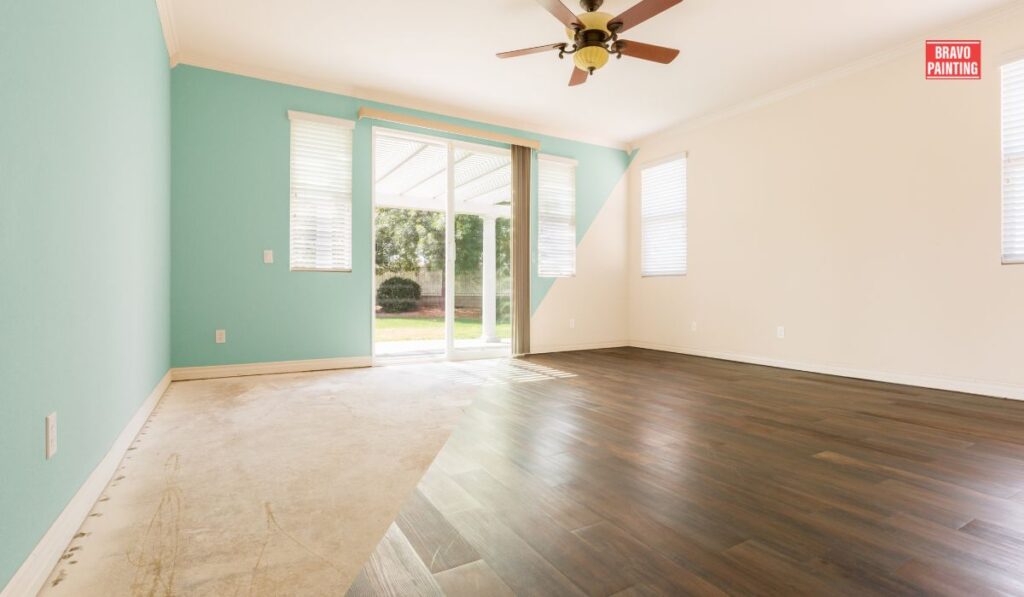Commercial interior painting plays a crucial role in enhancing the aesthetics and ambiance of a business space. However, it’s not without its challenges.
From improper preparation to poor color choices, there are several common mistakes that can undermine the outcome of a commercial painting project.
Understanding these pitfalls and knowing how to avoid them can ensure a successful and visually appealing result that reflects positively on your business.
Lack of Proper Surface Preparation:
One of the most common mistakes in commercial interior painting is inadequate surface preparation.
Rushing through or skipping this crucial step can lead to paint adhesion issues, uneven finishes, and premature peeling or cracking.
Before painting, ensure that surfaces are clean, smooth, and free of any dirt, dust, grease, or loose paint.
Properly sanding, priming, and filling cracks or holes will help create a smooth and durable base for the new paint.
Ignoring Environmental Factors:
Failure to consider environmental factors such as temperature, humidity, and ventilation can significantly impact the outcome of a commercial painting project.
Extreme temperatures or high humidity levels can affect paint drying times and adhesion, leading to subpar results.

It’s essential to schedule painting projects during optimal weather conditions and ensure proper ventilation to aid in the drying process.
Choosing the Wrong Paint Type:
Selecting the appropriate paint type for a commercial interior is crucial for achieving the desired results and ensuring durability.
Using the wrong paint finish or quality can result in issues such as poor coverage, streaking, or difficulty in cleaning.
Consider factors such as the level of traffic, maintenance requirements, and desired aesthetics when choosing between flat, eggshell, satin, or semi-gloss finishes.
Investing in high-quality, durable paints will provide long-lasting results and save you time and money in the long run.
Inadequate Color Selection:
Color choice plays a significant role in the overall look and feel of a commercial space.
However, selecting the wrong colors or failing to consider lighting conditions can result in an unappealing or mismatched appearance.
It’s essential to test paint colors in the actual space and consider how they will interact with natural and artificial lighting.
Consulting with a professional color expert or interior designer can help ensure that your color choices complement the space’s design and branding while creating a welcoming atmosphere for customers and employees.
Poor Application Techniques:
Improper paint application techniques can lead to streaks, drips, or uneven coverage, detracting from the final result.
Whether using brushes, rollers, or sprayers, it’s crucial to apply paint evenly and consistently, following proper painting techniques.
Avoid overloading brushes or rollers with paint, and always work in small sections to maintain a wet edge and prevent visible seams.
Taking the time to apply paint carefully and methodically will result in a professional-looking finish that enhances the overall appearance of your commercial space.
Skipping Primer:
Primer is often overlooked or skipped in commercial painting projects, especially when painting over previously painted surfaces.
However, using a high-quality primer is essential for promoting adhesion, hiding stains, and ensuring uniformity of the final paint finish.
Primer also helps seal porous surfaces and provides a smooth base for the topcoat, enhancing its durability and coverage.
By applying primer before painting, you can improve the overall quality and longevity of the paint job, saving time and money on future touch-ups or repainting.
Neglecting Safety Precautions:
Safety should always be a top priority when undertaking any commercial painting project.
Neglecting safety precautions such as wearing protective gear, using proper ventilation, and following manufacturer’s instructions for handling and disposing of paint products can lead to accidents or health hazards.
Ensure that all painters are equipped with safety glasses, gloves, respirators, and appropriate clothing to protect against exposure to paint fumes, chemicals, or accidents.
Additionally, proper ladder safety and fall protection measures should be implemented to prevent injuries while working at heights.
Lack of Communication:
Effective communication is essential for the success of any commercial painting project, especially when working with clients, contractors, or other stakeholders.
Failing to communicate clearly and regularly can lead to misunderstandings, delays, or dissatisfaction with the final results.
Establishing open lines of communication from the outset, outlining project timelines, expectations, and any specific requirements, can help ensure that everyone is on the same page and that the project progresses smoothly.
Regular updates and progress reports can also help address any issues or concerns promptly, preventing them from escalating into larger problems later on.
Not Testing Paint Samples:
Before committing to a specific paint color or finish for a commercial space, it’s essential to test paint samples in the actual environment to evaluate how they will look under different lighting conditions and alongside existing furnishings or decor.
Failing to test paint samples can result in unpleasant surprises, such as colors appearing darker or lighter than expected, or clashing with other elements in the space.

By painting small sections or swatches of different colors on the walls and observing them throughout the day, you can make an informed decision and ensure that the final paint choice meets your expectations.
Skimping on Quality:
While it may be tempting to cut costs by opting for cheaper paint products or hiring inexperienced painters, skimping on quality can lead to subpar results and costly repairs or repainting in the long run.
Investing in high-quality paints, materials, and experienced painters may entail a higher upfront cost but will ultimately pay off in terms of durability, longevity, and overall satisfaction with the finished project.
By prioritizing quality over price, you can ensure that your commercial interior painting project delivers lasting value and maintains its appearance for years to come.
Conclusion
By addressing these additional considerations, including the importance of primer, safety precautions, communication, paint testing, and prioritizing quality, you can further enhance the success and effectiveness of your commercial interior painting project.
Taking the time to properly prepare, communicate, and invest in quality materials and labor will ultimately result in a professional-looking finish that enhances the aesthetics and functionality of your business space, leaving a lasting impression on customers and visitors.
For expert guidance and professional painting services, visit Bravo Painting at Bravo Painting.
Our experienced team is dedicated to delivering exceptional results that meet your unique needs and exceed your expectations.
Contact us today to schedule a consultation and transform your commercial space with confidence.
FAQs
What are some common mistakes in commercial interior painting?
Some common mistakes include lack of proper surface preparation, ignoring environmental factors, choosing the wrong paint type, inadequate color selection, poor application techniques, skipping primer, neglecting safety precautions, lack of communication, not testing paint samples, and skimping on quality.
How can I avoid inadequate surface preparation?
Ensure surfaces are clean, smooth, and free of dirt, dust, grease, or loose paint before painting. Properly sand, prime, and fill cracks or holes to create a smooth and durable base for the new paint.
What environmental factors should I consider for a commercial painting project?
Consider temperature, humidity, and ventilation. Extreme temperatures or high humidity levels can affect paint drying times and adhesion. Schedule painting projects during optimal weather conditions and ensure proper ventilation.
How do I choose the right paint type for a commercial interior?
Consider factors such as the level of traffic, maintenance requirements, and desired aesthetics when choosing between flat, eggshell, satin, or semi-gloss finishes. Invest in high-quality, durable paints for long-lasting results.
What role does color selection play in commercial interior painting?
Color choice affects the overall look and feel of a space. Test paint colors in the actual space and consider how they interact with natural and artificial lighting. Consulting with a professional color expert can help ensure that your choices complement the space’s design and branding.
What are some tips for proper paint application techniques?
Apply paint evenly and consistently using brushes, rollers, or sprayers. Avoid overloading brushes or rollers with paint and work in small sections to maintain a wet edge and prevent visible seams.
Is primer necessary for commercial painting projects?
Yes, using a high-quality primer is essential for promoting adhesion, hiding stains, and ensuring uniformity of the final paint finish. Primer also helps seal porous surfaces and provides a smooth base for the topcoat.
How can I ensure safety during a commercial painting project?
Prioritize safety by wearing protective gear, using proper ventilation, and following manufacturer’s instructions for handling and disposing of paint products. Implement proper ladder safety and fall protection measures when working at heights.
Why is communication important in commercial painting projects?
Effective communication helps prevent misunderstandings, delays, or dissatisfaction with the final results. Establish open lines of communication from the outset, outlining project timelines, expectations, and specific requirements to ensure smooth progress.
Why should I test paint samples before making a final decision?
Testing paint samples allows you to evaluate how colors will look under different lighting conditions and alongside existing furnishings or decor. This helps you make an informed decision and ensure that the final paint choice meets your expectations.
Blog, Commercial Interior Painting

